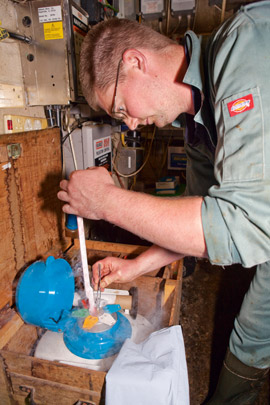Use genetics to breed disease out of herd

Dairy farmers may wish to consider new high immunity sires when selecting sires.
Standfirst: New genetic technology is boosting disease resistance. Gordon Miller, managing director for Semex UK, explains some of the new breeding lines available
Some cows in the herd are pretty much invisible – they calve, get milked, get back in-calf and that’s about the only time you’re aware of them. They don’t have mastitis problems, or go lame, or have other issues – they just seem to have an inner strength to resist disease and avoid health problems. The question is – why are these cows different to the others in the herd?
In a nutshell, it’s probably because these animals possess better genes for resistance to disease – they have stronger immunity. Until recently, though, geneticists haven’t had the tools to accurately identify animals that carry these genes and could pass them on to their progeny. Now, thanks to breakthroughs in immunogenetic science, they do.
Recently, a new line of “high-immunity” sires has been launched by Semex under the Immunity+ brand to bring the technology direct to the farmgate. This promises to significantly increase the rate of genetic progress in those health traits which, in the past, have proved difficult to improve with traditional methods.
| Heritability |
|---|
|
HERITABILITY
One of the key research findings that attracted Semex to immune response technology was the relatively high heritability of immune response – at approximately 25%. This means 25% of the differences between animals for immune response can be explained by the animals’ genetics. This is close to the heritability of production and conformation traits (see table below) and is far greater than the heritability of traits such as productive life (longevity), daughter fertility or disease incidence traits.
As a result, significant genetic gains for immune response over successive generations can be expected, as is achievable for production traits.
Research has found high immune responder cows (HIRs) have greater resistance to diseases such as mastitis, metritis, ketosis and retained placentas. Early indications show Johne’s disease is also reduced. And since Johne’s is caused by a mycobacterium, it is believed HIRs could also have greater immunity to TB, which is also caused by a mycobacterium.
In addition, Immunity+ sires are only classed as such after testing shows they score high for both types of acquired (adaptive) immune response – cell-mediated and antibody-mediated. This means they have, and transmit, a higher overall immunity, giving greater protection against a wide range of bacterial and viral diseases, rather than just a few specific ones.
Research also shows HIRs have a better response to vaccines and produce higher-quality colostrum with more antibodies. This is leading some early users of the Immunity+ bulls to keep the colostrum of their newly-calved daughters to build their colostrum banks.
| Heritability of various traits | |
|---|---|
| Trait | Heritability |
| Production | 25-35% |
| Conformation | 15-40% |
| Longevity | 8-10% |
| Calving ease | 6-7% |
| Daughter fertility | 4-7% |
| Disease incidence | 2-10% |
More online
Subscibe to receive your free digital edition of Dairy Update
